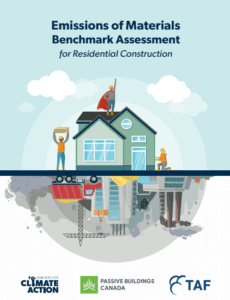What is embodied carbon in a home retrofit?
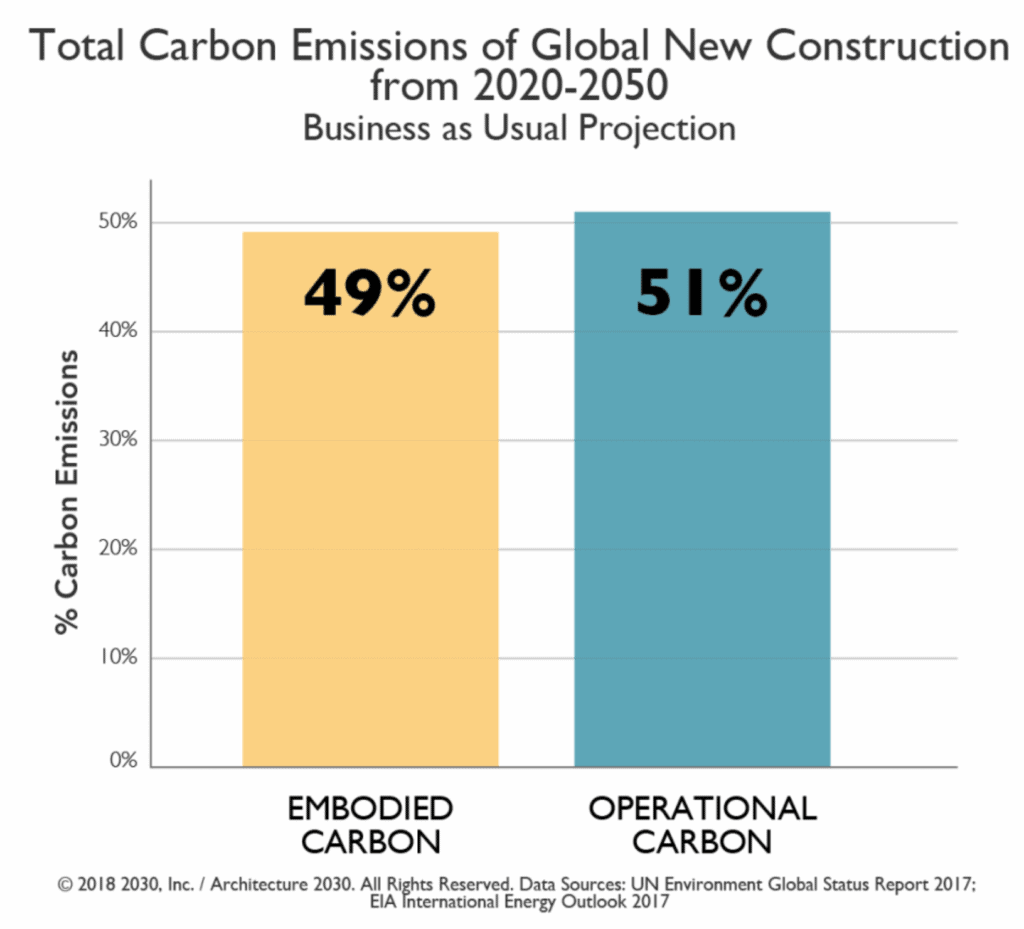
Embodied carbon refers to the greenhouse gas emissions arising from the manufacturing, transportation, installation, maintenance, and disposal of building materials.
It is a significant percentage of global emissions and requires urgent action to address it (Source: Carbon Leadership Forum).
Embodied carbon is the amount of carbon emitted during the construction of a building (e.g. carbon emitted to make concrete foundations, steel studs, and wall insulation, etc.). The extraction of raw materials, the manufacturing and refinement of materials, transportation, installation and disposal of old supplies can all produce embodied carbon emissions.
Whereas operational carbon is the amount of carbon emitted once a building is in use (e.g. heat pump to heat and cool, LED lighting, etc.).
…goal is to eliminate embodied carbon in buildings, materials, and infrastructure to create a just and thriving future.
Carbon Leadership Forum

Why is embodied carbon important?
“Embodied carbon will be responsible for almost half of the total new construction emissions between now and 2050.” – Carbon Leadership Forum (2024)
Start with this Carbon Leadership Forum introductory video “Embodied Carbon 101”
What can you do reduce embodied carbon in your home retrofit?
Ready to plan for less embodied carbon in your home deep energy retrofit?
First of all…
- Consider REDUCING the size of your conditioned space to lower operational carbon and embodied carbon emissions
- REUSE the existing building and materials where possible
- Source RECLAIMED building materials where feasible
- Remember to consider your ENVELOPE first, MECHANICALS second, and RENEWABLES last!
Big 3 Embodied Carbon Components in Your Home
Builders for Climate Action looked at 503 homes in Toronto.
They found that 73 percent of all material carbon emissions in the study come from just three material categories: concrete (33 percent for foundation walls, slabs and footings), insulation (26.1 percent for foundations, walls and roofs) and exterior cladding (13.4 percent).
- 33% CONCRETE in foundation walls, slabs and footings
- 26% INSULATION in foundations, walls and roofs
- 13% EXTERIOR CLADDING
When you are planning your deep energy retrofit consider eliminating the need for, reducing, and/or reusing these materials to lower embodied carbon emissions.
Or select alternatives with lower embodied carbon.
Builders for Climate Action propose the following targets. Look at your home energy retrofit and see whether you can do the best low embodied carbon retrofit available in your market.
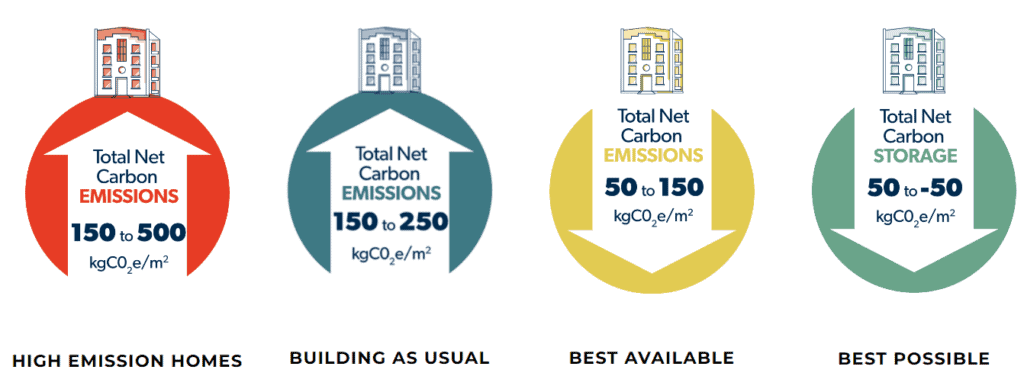
Steps to Lower Embodied Carbon in Your Home Retrofit
The following is a ranking of the highest embodied carbon building materials. To reduce embodied carbon in your home retrofit project, focus on reducing the use of or finding alternatives to the items higher up the list.
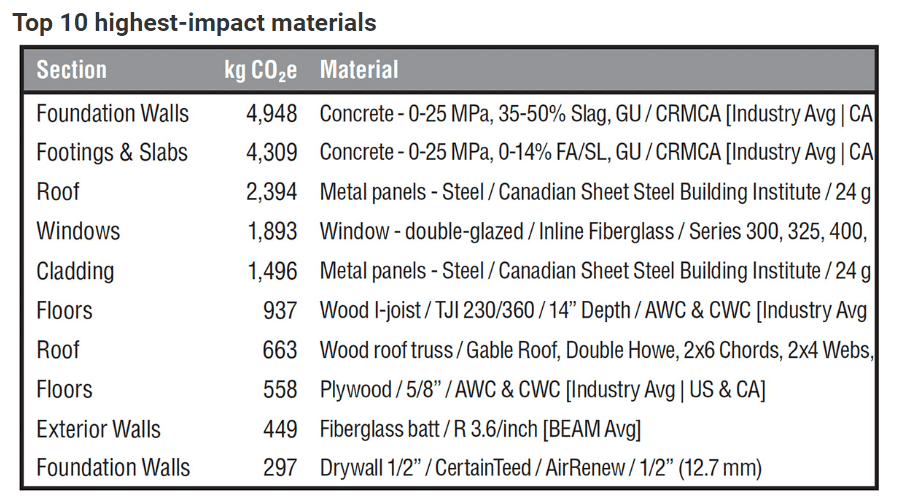
OK so what should you consider…
- First thing to consider is tightening up the ENVELOPE
- CONCRETE
- Look for and ask for “low-carbon concrete” which substitutes supplementary cementitious materials (SCMs) to reduce the Portland cement to make the concrete
- Minimize volume of concrete needed…focus concrete in areas where strength and durability required.
- Choose STEEL with recycled content
- Choose WOOD where feasible
- Add INSULATION
- Select lower embodied carbon insulation products where feasible
- Avoid foam when you can
- Use bio-based materials
- Limit or avoid petroleum-based materials

- Replace CLADDING
- Select lower embodied carbon cladding products where feasible
- Reuse where feasible
- Select wood products for lower embodied carbon
- Replace and upgrade WINDOWS
- Select higher performing windows to reduce operational carbon emissions in regions where the electrical grid is more carbon intensive (e.g. Alberta, Saskatchewan, New Brunswick, Nova Scotia, Northwest Territories, Nunavut)
- Upgrade MECHANICALS
- Ensure envelope has been addressed first
- Electrify where feasible
- Upgrade lighting to LED
- Replace space heating and cooling with heat pump
- Replace hot water heating with heat pump
- When appropriate select heat pump domestic clothes dryer
- Choose an electric range
- Consider installing or preparing for future Electric Vehicle charging
- Look into REFRIGERANTS
- Select refrigerants with lower Global Warming Potential (GWP)
- Reduce refrigerant leakage
- Add RENEWABLES
- Ensure envelope and mechanicals have been addressed first
- Make roof solar ready
- Prioritize installation of solar photovoltaics to reduce operational carbon emissions in regions where the electrical grid is more carbon intensive (e.g. Alberta, Saskatchewan, New Brunswick, Northwest Territories, Nova Scotia, Nunavut)

Tools to Reduce Embodied Carbon
Make lower embodied carbon material and product choices with help from the Low-Carbon Material Sourcing Guide from CLF BC.
Try the free BEAM Estimator Tool from Builders for Climate Action.
Join the Conversation about Embodied Carbon
Learn more by joining the building embodied carbon conversation in your area:
- Carbon Leadership Forum – Vancouver, BC
- Carbon Leadership Forum – Calgary, AB
- Carbon Leadership Forum – Toronto, ON
Further reading on embodied carbon:
- Builders for Climate Action – https://www.buildersforclimateaction.org
- CaGBC – Embodied Carbon: A Primer for Buildings in Canada (2022)
Frequently Asked Questions About Embodied Carbon
- How does embodied carbon emissions compare to operational carbon emissions for my home?
- In general, embodied carbon emissions can equal operational carbon emissions. In an electrified home in regions with cleaner electrical grids, the embodied carbon emissions of the materials can outweigh the operational carbon emissions indicating the importance of lowering embodied carbon in your home retrofit.
- Considering embodied carbon of new heat pump along with operational GHG emission reductions, when should I replace my natural gas furnace or electric baseboard heaters with a heat pump?
- Now or at least at end of life of existing space heater. Heat pumps are significantly more efficient and will likely reduce overall greenhouse gas emissions within first year.
- Considering embodied carbon of new heat pump along with operational GHG emission reductions, when should I replace my natural gas or electric hot water storage heater with a heat pump?
- Now or at least at end of life of existing water storage heater. Heat pumps are significantly more efficient and will likely reduce overall greenhouse gas emissions within first year.
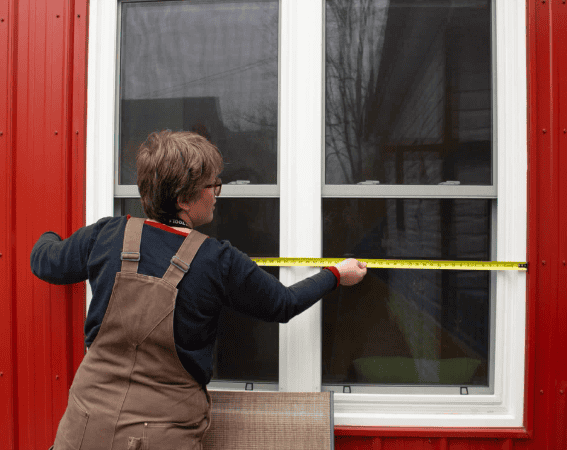
Start your deep energy retrofit today.
Save energy. Make your home more comfortable.
Have less maintenance. Keep more money in your pocket.
Glossary
Carbon Dioxide Equivalent (CO2e): The universal unit of measurement to indicate the global warming potential (GWP) of each GHG, expressed in terms of the GWP of one unit of carbon dioxide.
Carbon Footprint: A carbon footprint is a measure of the total amount of greenhouse gases, primarily carbon dioxide (CO2), emitted into the atmosphere each year by a person, organization, or activity. It reflects the impact of human activities on the environment in terms of carbon emissions.
Carbon Footprint of a Product (CFP): A Carbon Footprint of a Product (CFP) represents the total amount of GHG emissions and removals associated with a product throughout its life cycle, from raw material acquisition to production, distribution, use, and end-of-life disposal.
Embodied Carbon: The carbon emissions associated with the production of materials and the maintenance, construction, and demolition processes throughout the life cycle of a building. Measured in kg CO2e
Environmental Product Declaration (EPD): An Environmental Product Declaration is a document that provides standardized information about a product’s environmental impact throughout its lifecycle
Scope 1 Emissions: Direct greenhouse gas emissions from sources that are owned or controlled by a company, such as emissions from fuel combustion in company-owned vehicles or boilers.
Scope 2 Emissions: Indirect greenhouse gas emissions from the consumption of purchased electricity, heat, or steam by a company.
Scope 3 Emissions: Indirect greenhouse gas emissions that occur in a company’s value chain, including emissions from purchased goods and services, employee commuting, and the use and disposal of sold products.
